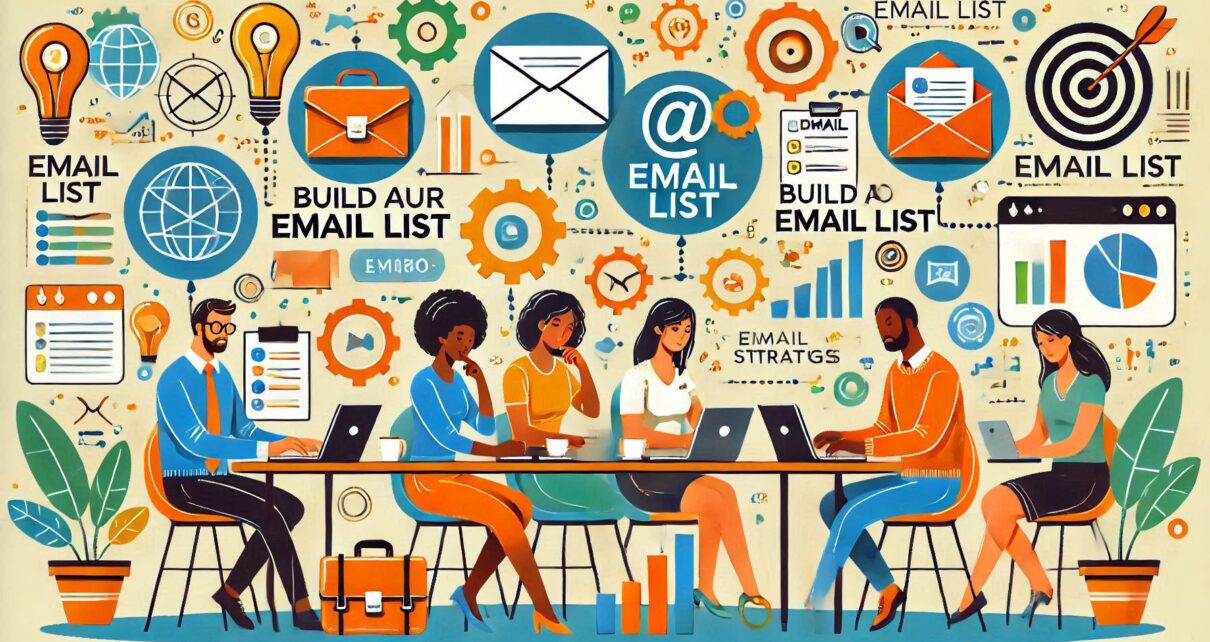Building an email list for your business is an essential part of creating a long-term, sustainable relationship with your customers. Whether you’re a small startup or an established company, email marketing remains one of the most effective ways to communicate with your audience and drive conversions. However, building a solid email list requires more than just asking people to sign up — it involves creating trust, offering value, and maintaining consistent communication.
This post will cover the steps involved in building an email list for your business, strategies for growing it, and tips on keeping your subscribers engaged. Whether you’re just starting out or looking to expand your existing list, this guide will give you the tools you need to succeed.
Table of Contents
The Importance of an Email List for Business
Before diving into the steps to build an email list, it’s important to understand why having a high-quality email list is crucial for your business:
- Direct Communication: Email allows you to communicate directly with your customers without relying on social media algorithms or third-party platforms.
- Increased Sales: Studies show that email marketing has a higher ROI than other forms of digital marketing, such as social media or paid ads.
- Build Relationships: Email provides a platform to nurture customer relationships, making it easier to turn one-time buyers into loyal customers.
- Segmenting Audience: With an email list, you can segment your subscribers based on their interests, behavior, or demographics, and tailor your messaging to meet their needs.
How to Build a High-Quality Email List
When it comes to building an email list, quality is far more important than quantity. A list filled with unqualified or uninterested subscribers can lead to lower engagement rates and higher unsubscribe rates. Here are some strategies to help you build a high-quality email list:
Create Compelling Lead Magnets
A lead magnet is something valuable that you offer to your potential customers in exchange for their email address. Here are some examples of effective lead magnets:
- Ebooks and Guides: Offering in-depth resources that provide value to your audience in exchange for their email address.
- Webinars: Hosting live webinars or recorded sessions on topics of interest.
- Discounts and Coupons: Offering a discount on a product or service for signing up.
- Checklists and Templates: Providing easy-to-use resources that make your subscribers’ lives easier.
- Free Trials: Giving a limited-time trial of your service to those who sign up.
- Quizzes and Surveys: Engaging your audience with interactive content like quizzes that provide personalized results.
Optimize Your Website for Email Sign-Ups
Your website should be designed to encourage visitors to sign up for your email list. Here are some techniques to optimize your website for email collection:
- Create a Visible Signup Form: Make sure your email sign-up form is easy to find. Use pop-ups, sticky bars, or prominent placements on your homepage.
- Use Landing Pages: Dedicated landing pages with compelling calls to action can significantly increase conversions. These pages should focus solely on getting the visitor to sign up.
- Leverage Exit-Intent Popups: When a visitor attempts to leave your site, show them a special offer or reminder to sign up for your list.
- Incorporate Signup Forms in Blog Posts: If you have a blog, include a sign-up form in your blog posts or at the end of each post.
Offer Clear Value
One of the most important factors in getting people to sign up for your email list is offering something of value. Make it clear why subscribing to your emails will benefit them. Whether it’s exclusive content, early access to promotions, or personalized offers, the value you provide should be front and center.
Use Social Media to Drive Sign-Ups
Your social media channels can be a powerful tool for growing your email list. Here are a few ways to encourage social media followers to sign up:
- Promote Your Lead Magnets: Regularly share links to your lead magnets on social media, and encourage followers to sign up to get access.
- Pin Posts on Facebook or Twitter: Pin posts that highlight your email list sign-up and the benefits of joining.
- Host Giveaways or Contests: Run social media contests where participants must sign up for your email list to enter.
- Share Testimonials or Results: Post success stories from your email subscribers to show the value of joining your list.
Leverage Referral Programs
Referral programs are an excellent way to grow your email list by incentivizing your current subscribers to refer others. Offering discounts, free products, or exclusive content as a reward for referrals can drive new sign-ups.
Use Paid Advertising
Paid advertising on platforms like Facebook, Google, or LinkedIn can help you attract new subscribers. By targeting the right audience, you can drive traffic to your landing pages and increase sign-ups. Ensure your ads clearly communicate the value of joining your email list and make the sign-up process easy.
How to Manage Your Email List
Building an email list is just the beginning. Once you have subscribers, it’s crucial to manage your list to ensure maximum engagement and minimize unsubscribes. Here are some strategies for managing your list effectively:
Segment Your Email List
Email segmentation involves dividing your email list into smaller, more targeted groups based on specific criteria such as demographics, location, purchase history, or engagement level. Segmentation allows you to send more personalized and relevant content to your subscribers, increasing engagement and conversion rates.
Examples of common segmentation strategies include:
- New Subscribers: Send a welcome series to new subscribers to introduce them to your brand.
- Engaged Subscribers: Target highly engaged subscribers with exclusive offers or content.
- Inactive Subscribers: Reach out to subscribers who haven’t interacted with your emails in a while with re-engagement campaigns.
Maintain List Hygiene
List hygiene refers to regularly cleaning your email list to remove inactive or unengaged subscribers. Not only will this improve your engagement rates, but it can also help avoid your emails being marked as spam.
- Remove Unsubscribed or Bounced Emails: Regularly update your email list to remove invalid or unsubscribed addresses.
- Engagement-Based Cleanup: Consider removing or re-engaging subscribers who haven’t opened or clicked your emails in several months.
Use an Email Marketing Platform
An email marketing platform (like Mailchimp, ConvertKit, or Klaviyo) is essential for managing your email list. These platforms allow you to:
- Collect email addresses through sign-up forms and landing pages.
- Segment your list to send targeted campaigns.
- Automate emails like welcome sequences, birthday offers, or abandoned cart reminders.
- Analyze your email campaigns’ performance and adjust strategies accordingly.
How to Craft Engaging Emails
Once you have your email list, it’s important to create content that keeps your subscribers engaged and encourages them to take action. Here are some tips for crafting compelling emails:
Write Attention-Grabbing Subject Lines
The subject line is the first thing your subscribers see, and it plays a significant role in whether they open your email. Make it clear, concise, and enticing. Some tips include:
- Personalization: Include the subscriber’s name or relevant information.
- Urgency: Use words like “limited time” or “last chance” to create a sense of urgency.
- Curiosity: Tease valuable content inside the email.
- Offer Value: Highlight the benefit of opening the email (e.g., “Save 20% on Your Next Purchase”).
Design Mobile-Friendly Emails
More than half of all emails are opened on mobile devices. Ensure your emails are optimized for mobile by:
- Using a responsive design that adjusts based on screen size.
- Keeping your content short and easily scannable.
- Including large, tappable buttons.
Include a Clear Call to Action (CTA)
Every email should have a clear, actionable next step for your subscribers. Whether it’s making a purchase, reading a blog post, or filling out a survey, make sure your CTA stands out and is easy to follow.
Personalize Your Emails
Personalization goes beyond using a subscriber’s name. You can personalize emails based on:
- Purchase History: Recommend products based on previous purchases.
- Location: Tailor offers based on the subscriber’s location.
- Behavior: Send targeted emails based on how subscribers have interacted with your emails in the past.
How to Grow and Scale Your Email List
Once you’ve built a solid foundation, it’s time to focus on growing your email list. Here are some advanced tactics to scale your efforts:
- Content Upgrades: Offer bonus content (like a PDF or template) within blog posts to entice readers to sign up.
- Leverage Influencers: Partner with influencers or affiliates to promote your email list to their audience.
- Retargeting Ads: Use Facebook or Google retargeting ads to drive traffic to your email sign-up page.
- Cross-Promotions: Partner with complementary businesses to cross-promote your email lists.
How to Analyze and Improve Your Email Campaigns
Once your email list is established, it’s important to continually monitor and improve your email marketing efforts. Use analytics to track the performance of your campaigns and identify areas for improvement.
Key metrics to track include:
- Open Rate: The percentage of people who open your emails.
- Click-Through Rate (CTR): The percentage of people who click on a link within your email.
- Conversion Rate: The percentage of people who take the desired action (e.g., make a purchase).
- Unsubscribe Rate: The percentage of people who unsubscribe from your list.
A/B testing can also be a valuable tool to optimize your emails. Test different subject lines, CTAs, or email copy to see what resonates best with your audience.
Key Tips for Building an Effective Email List
- Offer Value in Exchange for Email Addresses Always offer something valuable in return for a visitor’s email address. Lead magnets like exclusive content, discounts, or downloadable resources help build trust and encourage sign-ups.
- Use Clear and Compelling CTAs Your call-to-action (CTA) should be simple and straightforward. Whether it’s “Get Your Free Guide Now” or “Join Our Exclusive Email List,” make sure the action is clear and appealing.
- Keep Sign-Up Forms Short and Simple Limit the amount of information you ask for on your email sign-up forms. The more fields there are, the less likely people are to complete the form. Name and email are often sufficient.
- Optimize for Mobile Devices A large portion of emails is read on mobile devices, so ensure that your sign-up forms, email content, and CTAs are mobile-friendly. Keep your forms and landing pages simple and responsive.
- Offer Exclusive Access Make your subscribers feel like VIPs by offering them exclusive content, early access to new products, or special offers only available to your email list.
- Ensure Consistency in Communication Once a user subscribes, set clear expectations for how often they can expect emails and stick to that schedule. Consistent communication helps build trust and reduces unsubscribe rates.
- Use Testimonials and Social Proof Highlight how other customers have benefited from your email list, whether through success stories, case studies, or positive reviews. Social proof can increase conversions.
Mistakes to Avoid in Email List Building for Business
- Buying Email Lists Purchasing email lists can result in poor-quality subscribers who are unlikely to engage with your content. Focus on organic growth and building relationships with real people who are genuinely interested in your brand.
- Neglecting Email Segmentation Sending generic emails to your entire list can lead to disengagement. Not segmenting your list based on user behavior, preferences, or demographics is a major mistake. Personalization is key to increasing engagement and conversions.
- Overloading Subscribers with Emails Bombarding subscribers with too many emails can lead to unsubscribes. Find a balance in your communication frequency. Focus on sending valuable, relevant content, not just promotional emails.
- Not Having a Clear Value Proposition If you don’t clearly communicate the benefits of signing up for your email list, potential subscribers will hesitate. Make sure you highlight what subscribers will gain, such as exclusive offers or valuable content.
- Not Cleaning Your Email List Regularly Failing to regularly clean your email list by removing inactive subscribers or bounced emails can harm your sender reputation and reduce your engagement rates. Regular list hygiene is crucial for maintaining list health.
- Ignoring Mobile Optimization Many users open emails on mobile devices, so emails that aren’t optimized for mobile may result in high bounce rates and unsubscribes. Ensure your emails are responsive and easily readable on smaller screens.
- Using a Poor Email Design A cluttered or confusing email design can turn subscribers away. Keep your emails simple, visually appealing, and easy to navigate, with a clear CTA and engaging visuals.
Benefits of Building an Email List for Your Business
- Direct and Personalized Communication Email allows you to communicate directly with your audience in a personal way. This relationship is more intimate compared to social media, where algorithms control what content users see.
- High ROI Email marketing consistently outperforms other forms of digital marketing, delivering a high return on investment. With the right strategies, email campaigns can yield substantial sales and growth.
- Increased Customer Retention By maintaining regular communication with your subscribers and offering them exclusive deals or content, you can foster loyalty and increase repeat purchases. Email is an effective way to nurture long-term relationships.
- Better Segmentation and Targeting With an email list, you can segment subscribers based on interests, behavior, or demographics, ensuring your messages are highly relevant. Targeted emails lead to better engagement and conversion rates.
- Building Brand Awareness Regularly sending emails keeps your brand top of mind for subscribers. It’s an opportunity to showcase your expertise, announce new products, and build trust with your audience.
- Cost-Effective Marketing Compared to paid advertising or traditional marketing methods, email marketing is relatively low-cost, especially when you use an email platform. With minimal investment, you can reach a wide audience and see a great return.
- Measurable Results Email marketing platforms offer powerful analytics, allowing you to track open rates, click-through rates, and conversion rates. This data helps you refine your campaigns and improve their effectiveness over time.
Conclusion
Building and growing an email list is a critical component of any business’s marketing strategy. By offering value, leveraging multiple channels to grow your list, and continually optimizing your email campaigns, you can create a highly engaged audience that drives sales and fosters long-term customer loyalty.
Remember that building an email list is a gradual process, but with patience and persistence, it can become one of your most powerful marketing assets.
FAQs About Building and Managing an Email List
How do I grow my email list quickly?
You can grow your email list quickly by offering compelling lead magnets, promoting your sign-up forms across social media, running contests or giveaways, and using paid ads to drive traffic to your sign-up page.
How often should I send emails to my list?
The frequency of your emails depends on your business and audience. However, it’s important not to overwhelm subscribers. Typically, sending one to four emails per month is a good starting point.
How do I keep my email list engaged?
To keep your email list engaged, send valuable and relevant content, segment your list for personalized communication, and ensure your emails are visually appealing. Including exclusive offers or promotions also helps maintain interest.
What should I do if my email open rates are low?
If your email open rates are low, try improving your subject lines, optimizing your emails for mobile, segmenting your audience better, and testing the timing of your emails to see when your subscribers are most likely to open them.
Can I buy an email list to jump-start my efforts?
While buying email lists might seem like an easy shortcut, it is not recommended. Purchased lists typically consist of unqualified leads and can damage your sender reputation. It’s best to build your list organically.
How do I remove inactive subscribers from my list?
You can identify inactive subscribers by tracking engagement rates (opens, clicks) over time. Reach out with a re-engagement campaign and remove subscribers who haven’t interacted with your emails after a certain period.
What are the best email marketing platforms for beginners?
For beginners, platforms like Mailchimp, ConvertKit, and Moosend are user-friendly and offer scalable solutions. These tools provide easy-to-use templates, list management features, and analytics to help you grow and optimize your email list.




